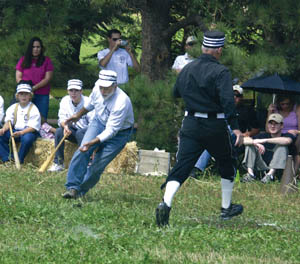
At least not for the record.
“Everyone enjoyed themselves” said All-Stars catcher Roger “Digger” Hadix. “It was close for a while, and then the All-Stars showed their muscle.”
In an effort to maximize home field advantage, Rock Ledge player/coach Andy “Anvil” Morris had left the hayfield grass a few inches high ('to slow down their red- hots,” as he put it) and, when his team batted in the ninth inning, hoping to rally from a 14-3 deficit, he stationed Patches, the ranch cow, about 20 feet behind second base as a kind of favorable interference.
“We had a good time,” added Richard “Rube” Foster, one of the pitching and hitting leaders for the visiting old-time baseball specialists.
So no vindication at all?
Not that we're going to tell the press about,” Foster said. “Come on down to the saloon later on and we might have more to say.” Whew. And for a moment there it seemed as if 19th century yellow sports journalism was dead.
The game, featuring gloveless players in 1800s-style baseball uniforms, was played by early 1860s rules. These included underhand pitching, a single umpire standing to one side of home plate and numerous outs (including foul balls) resulting from balls caught on one hop.
A true old-timey moment occurred when Morris (also the ranch manager) was called away for about half an inning to deal with a reported snake on one of the ranch paths. It turned out to be a false alarm.

A crowd of about 100 “cranks” (spectators) surrounded the field, shouting “huzzah” for the not-quite-frequent-enough Cloud Buster hits and stellar fielding plays. Also, in the spirit of that era, the crowd “helped” the umpire make calls favorable to the local lads. But even the cranks had a bit of an off-day. In last year's game, two deep flies by All-Stars had been caught by spectators and flipped back to Cloud Buster fielders for outs; this year, a ball driven onto the Rock Ledge House front porch (in deep right field), was forgetfully rolled back onto the field while the gleeful All-Star hitter sped for extra bases.
As for Morris' positioning of Patches, who had been grazing beyond centerfield for the first eight innings, he deadpanned that, after all, “we were grazing in her pasture, and the grass was juicier behind second. It just happened to be during the game, and we were losing.”
The cow placidly chewed grass in the ninth inning while the Cloud Busters, aided by the Cloud Busters' first-ever female player in the “manly” game (Rock Ledge junior docent Abby Dorman), came up short despite an error-aided six-run rally. The All-Star players, most of them from the Denver area, were from teams in the Colorado Vintage Base Ball Association. Ian “Traveler” Tinney, an association player who acted as umpire, said he and his son, Dathan “Cannibal” Tinney play about 40 games a year for a Berthoud team.
The 2005 Cloud Buster triumph had followed six losses and one tie in the games since the annual game started. The team consists mostly of City Parks employees and Rock Ledge volunteer docents. The historic site is owned by Colorado Springs.
Morris took this year's defeat with the gentlemanly attitude well known for residents of the Colorado City area in the days of yore. “We may have lost, but our women still find us handsome,” he said, hopefully.
As for next year, since Patches by herself did not get in the defender's way in an appreciable manner, Morris gave away a scheme to enhance that strategy. He's thinking of bringing the ranch sheep flock onto the field as well, he said.
Westside Pioneer article